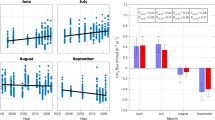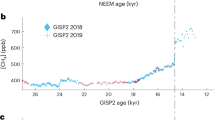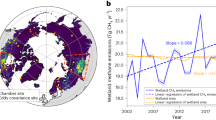Abstract
Terrestrial wetland emissions are the largest single source of the greenhouse gas methane1. Northern high-latitude wetlands contribute significantly to the overall methane emissions from wetlands, but the relative source distribution between tropical and high-latitude wetlands remains uncertain2,3. As a result, not all the observed spatial and seasonal patterns of atmospheric methane concentrations can be satisfactorily explained, particularly for high northern latitudes. For example, a late-autumn shoulder is consistently observed in the seasonal cycles of atmospheric methane at high-latitude sites4, but the sources responsible for these increased methane concentrations remain uncertain. Here we report a data set that extends hourly methane flux measurements from a high Arctic setting into the late autumn and early winter, during the onset of soil freezing. We find that emissions fall to a low steady level after the growing season but then increase significantly during the freeze-in period. The integral of emissions during the freeze-in period is approximately equal to the amount of methane emitted during the entire summer season. Three-dimensional atmospheric chemistry and transport model simulations of global atmospheric methane concentrations indicate that the observed early winter emission burst improves the agreement between the simulated seasonal cycle and atmospheric data from latitudes north of 60° N. Our findings suggest that permafrost-associated freeze-in bursts of methane emissions from tundra regions could be an important and so far unrecognized component of the seasonal distribution of methane emissions from high latitudes.
This is a preview of subscription content, access via your institution
Access options
Subscribe to this journal
Receive 51 print issues and online access
$199.00 per year
only $3.90 per issue
Buy this article
- Purchase on Springer Link
- Instant access to full article PDF
Prices may be subject to local taxes which are calculated during checkout


Similar content being viewed by others
References
Mikaloff Fletcher, S. E., Tans, P. P., Bruhwiler, L. M., Miller, J. B. & Heimann, M. CH4 sources estimated from atmospheric observations of CH4 and its 13C/12C isotopic ratios: 1. Inverse modeling of source processes. Glob. Biogeochem. Cycles 18, GB4004 (2004)
Dlugokencky, E. J. et al. Atmospheric methane levels off: Temporary pause or a new steady-state? Geophys. Res. Lett. 30, 1992 (2003)
Miller, J. B. et al. Airborne measurements indicate large methane emissions from the eastern Amazon basin. Geophys. Res. Lett. 34, L10809 (2007)
Dlugokencky, E. J., Steele, L. P., Lang, P. M. & Masarie, K. A. The growth rate and distribution of atmospheric methane. J. Geophys. Res. 99, 17021–17043 (1994)
Reeburgh, W. S. et al. A CH4 emission estimate for the Kuparuk River basin, Alaska. J. Geophys. Res. 103, 29005–29013 (1998)
Christensen, T. R. et al. Trace gas exchange in a high-arctic valley 1. Variations in CO2 and CH4 flux between tundra vegetation types. Glob. Biogeochem. Cycles 14, 701–713 (2000)
Friborg, T., Christensen, T. R., Hansen, B. U., Nordstroem, C. & Soegaard, H. Trace gas exchange in a high-arctic valley 2. Landscape CH4 fluxes measured and modeled using eddy correlation data. Glob. Biogeochem. Cycles 14, 715–723 (2000)
Gedney, N., Cox, P. M. & Huntingford, C. Climate feedback from wetland methane emissions. Geophys. Res. Lett. 31, L20503 (2004)
Bousquet, P. et al. Contribution of anthropogenic and natural sources to atmospheric methane variability. Nature 443, 439–443 (2006)
Christensen, T. R. Methane emission from Arctic tundra. Biogeochemistry 21, 117–139 (1993)
Fan, S. M. et al. Micrometeorological measurements of CH4 and CO2 exchange between the atmosphere and subarctic tundra. J. Geophys. Res. 97, 16627–16644 (1992)
Corradi, C., Kolle, O., Walter, K., Zimov, S. A. & Schulze, E.-D. Carbon dioxide and methane exchange of a north-east Siberian tussock tundra. Glob. Change Biol. 11, 1910–1925 (2005)
Whalen, S. C. & Reeburgh, W. S. A methane flux time series for tundra environments. Glob. Biogeochem. Cycles 2, 399–409 (1988)
Walter, K. M., Zimov, S. A., Chanton, J. P., Verbyla, D. & Chapin, F. S. Methane bubbling from Siberian thaw lakes as a positive feedback to climate warming. Nature 443, 71–75 (2006)
Hargreaves, K. J., Fowler, D., Pitcairn, C. E. R. & Aurela, M. Annual methane emission from Finnish mires estimated from eddy covariance campaign measurements. Theor. Appl. Climatol. 70, 203–213 (2001)
Tokida, T. et al. Episodic release of methane bubbles from peatland during spring thaw. Chemosphere 70, 165–171 (2007)
Bliss, L. C. & Matveyeva, N. V. in Arctic Ecosystems in a Changing Climate: An Ecophysiological Perspective (eds Chapin, F. S. III, Jefferies, R. L., Reynolds, J. F., Shaver, G. R. & Svoboda, J.) 59–89 (Academic, 1992)
Meltofte, H., Christensen, T. R., Elberling, B., Forchhammer, M. C. & Rasch, M. (eds) High-Arctic Ecosystem Dynamics in a Changing Climate. Advances in Ecological Research Vol. 40 (Elsevier, 2008)
Christiansen, H. H. et al. Holocene environmental reconstruction from deltaic deposits in northeast Greenland. J. Quat. Sci. 17, 145–160 (2002)
Krol, M. C. et al. The two-way nested global chemistry-transport zoom model TM5: algorithm and applications. Atmos. Chem. Phys. 5, 417–432 (2005)
Bergamaschi, P. et al. Satellite chartography of atmospheric methane from SCIAMACHY on board ENVISAT. 2. Evaluation based on inverse model simulations. J. Geophys. Res. 112, D02304 (2007)
Walter, B. P., Heimann, M. & Matthews, E. Modeling modern methane emissions from natural wetlands. 2. Interannual variations 1982-1993. J. Geophys. Res. 106, 34207–34217 (2001)
Brown, J., Ferrians, O. J., Heginbottom, J. A. & Melnikov, E. S. Circum-arctic Map of Permafrost and Ground-Ice Conditions. USGS Circum-Pacific Map Series CP-45 (scale 1:10,000 000) (US Geological Survey, 1997)
Acknowledgements
This work was carried out under the auspices of the GeoBasis programme and part of the Zackenberg Ecological Research Operations funded by the Danish Ministry of the Environment and the ISICaB project funded by the Commission for Scientific Research in Greenland (KVUG). ASIAQ–Greenland Survey provided climate data. The work was also supported by the Swedish Research Councils VR and FORMAS. We thank P. Bergamachi (JRC) and J.-F. Meirink (KNMI) for providing the TM5 model setup. T. Tagesson helped with the field work in Zackenberg. We are grateful for comments on earlier versions of this manuscript from A. Lindroth and B. Christensen.
Author Contributions T.R.C., M.P.T., M.M., C.S. and L.S. designed the field research; M.M. designed, constructed and set up the automatic measurement system in Zackenberg; C.S. operated the system and performed manual measurements; M.M. performed data analysis; E.D. and S.H. provided atmospheric CH4 data and designed and ran the atmospheric transport model experiments; T.R.C., M.M., S.H. and E.D. drafted the manuscript.
Author information
Authors and Affiliations
Corresponding author
Supplementary information
Supplementary Information
This file contains Supplementary Figures and Legends 1-3, Supplementary Tables 1-2, Supplementary Notes and Supplementary Discussion. (PDF 1084 kb)
PowerPoint slides
Rights and permissions
About this article
Cite this article
Mastepanov, M., Sigsgaard, C., Dlugokencky, E. et al. Large tundra methane burst during onset of freezing. Nature 456, 628–630 (2008). https://doi.org/10.1038/nature07464
Received:
Accepted:
Published:
Issue Date:
DOI: https://doi.org/10.1038/nature07464
This article is cited by
-
Degradation Reduces Microbial Richness and Alters Microbial Functions in an Australian Peatland
Microbial Ecology (2023)
-
Recent Advances and Challenges in Monitoring and Modeling Non-Growing Season Carbon Dioxide Fluxes from the Arctic Boreal Zone
Current Climate Change Reports (2023)
-
Extremely wet summer events enhance permafrost thaw for multiple years in Siberian tundra
Nature Communications (2022)
-
The Arctic Carbon Cycle and Its Response to Changing Climate
Current Climate Change Reports (2021)
-
Remote sensing northern lake methane ebullition
Nature Climate Change (2020)
Comments
By submitting a comment you agree to abide by our Terms and Community Guidelines. If you find something abusive or that does not comply with our terms or guidelines please flag it as inappropriate.



